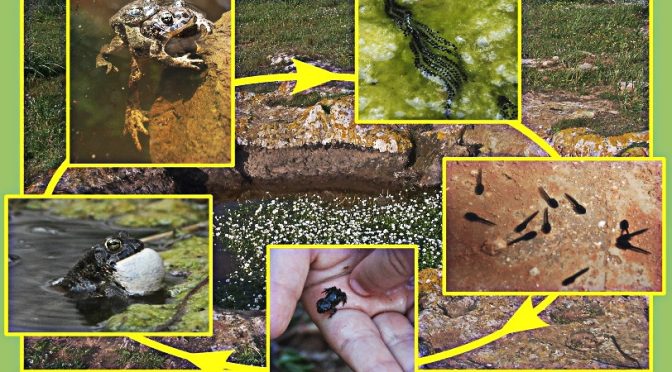Views: 765
In Menorca we currently have two species of amphibians: the frog and the green toad. Another species of toad was introduced some fourteen years ago with aquatic plants for the garden. The frog and the green toad, also, are species that were introduced here but in ancient times. The remains of green toads have been found at talayotic sites. Another species which was already living in Menorca before the arrival of humans was the ferret, but it became extinct and is now found just in the Serra de Tramuntana in Mallorca. The habitats of green toads are found only in Corsica, Sardinia, the Italian Peninsula, Mallorca, Menorca and Ibiza.
The body of the toad is robust, with a characteristic camouflage colouring, of a whitish background and green marks. The female also has red spots. The back is full of warts and the ventral part is granulated. At the nape, two lumps stand out which are the parotid glands. These glands expel a very disagreeable smelling substance to discourage predators from eating them. The pupils of the eyes are horizontal and elliptical. They do not have teeth. They are not adapted to moving by jumping like frogs but rather they walk rapidly. They live in open spaces, especially agrarian, without the need to have water nearby. They are difficult to see because they appear at twilight. They are active all year and do not hibernate. They eat small animals, insects, snails and various others.
One of the most spectacular characteristics of these amphibians is their method of reproduction. The green toads produce their young in temporary ponds, as much in natural as in artificial ones. Towards the end of the winter and the beginning of the spring, the males try to attract the females with their cry. It is a high-pitched, tremulous call sound. Once it finds a mate, the male embraces the female across the shoulders and grabs her by the armpits. It stays like this while the female ejects the eggs and the male the sperm synchronizing their actions. As a result gelatinous strands are formed that are up to two metres long, filled with black dots each about 1.5 mm, which are the eggs. These strands can hold approximately a thousand to two thousand eggs, most of which do not reach adulthood. Frogs are quite different, laying eggs in more or less spherical gelatinous masses rather than in strands. The time of reproduction varies depending on the weather during the year. They usually have another egg laying time at the end of the summer and beginning of the autumn. During years without much rain they are unable to reproduce in many ponds due to the lack of water.
The eggs hatch within a week depending on the temperature of the water. When the larvae hatch they are popularly known as tadpoles. They look like a head with a tail. They are born more or less in contact with the bottom of the pond, but swim upwards looking for the light and the warmth of the sun. At this time they have many predators: dragon-fly lavas, water beetles, triops, water snakes , water birds… Those that survive, at the end of forty days, start their metamorphosis. Their transformation is radical. They first start growing back legs, then front legs and finally the tail disappears. This results in animals the shape of adults but of only 15 mm, which have also changed their respiratory system. The small toads then come out of the water, all in one go. So many that it seems as though it is raining toads. Now they start their terrestrial life, independent of any ponds of water.
The green toad is a protected species. In Ibiza it is in danger of extinction. In Mallorca and Menorca, the populations are greater though many of their breeding areas have disappeared. In Menorca, they are concentrated mainly in the districts of Ciutadella and Sant Lluís. They are rarely found in the non-calcareous ground of the northern part of the island. Their principal threats are the alteration to their breeding areas and the surroundings. Intensive farming has degraded some of these areas, either from desiccation or contamination. Many areas are protected under the LIFE Basses project.
Class: Amphibia
Order: Anura
Family: bufonidae
Species: Bufotes balearicus
Popular names: Calàpet (cat), Sapo verde, Sapo balear (esp), Crapaud de Baléares (fra), Rospo smeraldino (it), Balearic green toad (eng)
Distribution: Italian Peninsula, Sicily, Sardinia, Corsica, Mallorca, Menorca and Ibiza
Size: Females up to 10 cms. Males much smaller up to 8 cms
Habitat: Open farmland. Breeding in temporary ponds
Feeding: Insects
Reproduction: oviparous. Metamorphosis of amphibians.
Conservation state: vulnerable
Legal Protection: Protected at European Level by the Berne Convention and the Habitats Directive. Species in special protection RD 139/20112
(Article published by Montse Bau and Tòfol Mascaró, biologists of GOB Menorca, in the Xoc section of the Menorca daily paper, 24/10/2018.)

